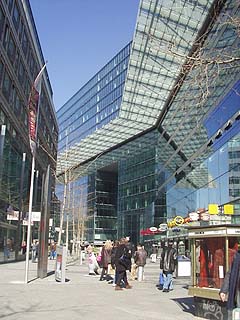
Surveys
DJC.COM
July 17, 2003
Europe points the way to sustainability
Coffman Engineers

Rosenow
|
With this question in mind, I traveled to Germany to attend the world’s largest trade show for the building services industry. I discovered that European designers experience many of the same challenges that we do, but with increased urgency. What is different is how they approach these challenges.
Although many design strategies utilized in Europe are familiar, I also found a variety of products and strategies gaining popularity there that are either nonexistent or in the early stages of development here.
Our own design community would be well advised to keep an eye on the building design industry across the Atlantic for a preview of what our own future may look like in the coming years.
Differences
Europeans face expensive energy costs that we have been protected from so far. Electricity, natural gas and heating oil cost two to three times what we pay. Half of European energy is imported, a figure that is estimated to increase to 70 percent by 2030, making them more vulnerable than we to global fluctuations in energy prices and availability.
Also, all of the member countries of the European Union (EU) signed the Kyoto Protocol, requiring drastic reductions in greenhouse gas emissions. The U.S. did not sign this agreement.
Finally, durability and efficient use of resources, including energy, water and materials, are key values in the European culture due to much denser populations and fewer natural resources. They approach building design with the intention of a 50- to 100-plus-year lifespan compared to the 30- to 50-year lifespan that we design to in the U.S.
Yet demand for energy and resources are rising in Europe, as in all developed nations. How will they meet this demand? The European answer is conservation.
Aggressive legislation

Photo courtesy of Coffman Engineers
This shopping mall and office in Berlin uses a double-skin facade to provide natural ventilation and sound attenuation while channeling daylight.
|
Last January, the EU parliament established a framework of integrated energy performance standards for all new commercial and residential construction, as well as buildings undergoing substantial renovation. Called the Directive 2002/91/ED of the European Parliament and of the Council on the Energy Performance of Buildings, or EnEV (Energieeinsparverordnung in German), it was created to help member countries meet Kyoto Protocol requirements and reduce their energy dependency. The focus is on measures that are most cost effective.
EnEV requires EU countries to calculate buildings’ energy consumption; specify maximum values for energy consumption; improve energy efficiencies in renovated buildings; and undertake regular inspections of boilers and air conditioning systems. Each member country is responsible for defining a practical application of this framework, appropriate to their diverse climates and cultures. With only a few exceptions, these standards must be met within three years — creating an enormous challenge for European designers.
Shared responsibility
Due to high taxes and capitalization, the commercial building industry in Europe is owner/tenant driven. EnEV recognizes that owners and renters of commercial buildings have vastly different interests in energy conservation. Although the renter pays the energy bill, the owner pays all first costs and maintenance costs for building materials, insulation and mechanical systems.
Under EnEV, buildings must be evaluated for energy performance every five years. Score sheets called “energy passports” outline the building’s performance relative to the minimum standards and must be permanently displayed.
Energy passports are required before any new residential or commercial project is granted a building permit. Public buildings must also display thermostats showing both indoor and outdoor temperatures compared to recommended design temperatures. Prospective tenants can then select facilities with the most attractive energy performance ratings.
Sustainable strategies
Many sustainable energy usage practices are already in place in Europe, where relatively simple conservation concepts result in substantial energy savings.
Seasonal temperatures inside and out. Europeans set their thermostats differently than we do. In general they are more accepting of a broad indoor temperature range, allowing their buildings to fluctuate between 68 and 79 degrees. In newer buildings with direct digital control systems, indoor temperatures are continually adjusted to within 15 degrees of the actual outdoor temperature during moderate weather conditions.
This is similar to the “deadband” approach required by many energy codes in the U.S., which is an indoor temperature range within which the mechanical system does not operate. However, the typical indoor design temperature range in U.S. buildings is narrow, between 70 to 75 degrees, which requires considerably more energy to maintain.
Windows that open. Europeans are true believers in the benefits of fresh air and sunlight. In buildings with less than 20 stories, windows are designed to open, permitting natural (and free) ventilation. Work areas ring the exterior of the building, placing as many people as possible with access to natural light and views. By utilizing building envelope strategies such as double skin façades, even office buildings located in busy downtown areas can benefit from natural ventilation.
De-centralized climate conditioning systems. As in the U.S., there is strong interest to move away from the traditional central air handling unit system in Europe. Buildings are strategically laid out so that areas with specific climate conditioning needs, or unique operating schedules, can be heated or cooled individually with separate air handling systems. This way the zone in a building with the greatest heating or cooling needs does not drive the entire building system. In most cases, added costs are offset by long-term energy savings.
Unconditioned entries and halls. In European buildings, most entryways and transition areas are neither heated nor cooled. Many Europeans comment that they find the blast of conditioned air that welcomes them into U.S. buildings uncomfortable, and an unnecessary use of energy.
Substituting solar. In the Netherlands, all new buildings must obtain at least 20 percent of their energy from renewable sources. Therefore solar panels are common, and buildings are carefully positioned to take advantage of active and passive solar gains.
Eliminating refrigerants. Refrigerants are strictly forbidden in new or renovated mechanical systems in several European countries. Instead designers must incorporate strategies such as evaporative cooling, or natural-gas-fired absorption chillers that use thermal energy instead of mechanical energy to create cooling.
Innovative technologies. In new buildings and buildings undergoing substantial renovations in Switzerland, only 5 watts per square meter of the building equipment load can be handled with a traditional mechanical system. The rest must be handled with alternative technologies. Other European countries have similar limits, which has created a strong demand for innovative products.
Many European manufacturers say they have not been able to offer their products in the U.S. because of the costs and difficulties involved in converting from metric to English units, as well as the cost to get their products UL rated. They have also experienced difficulties gaining acceptance of these new technologies in our market, which can be slow to change.
Promising future
European designers are admittedly concerned about how they will meet the challenging demands of the new energy standards. But they are also experiencing a certain professional excitement towards the promising benefits these standards are anticipated to achieve.
Across the Atlantic, as our own uncertain energy future unfolds, we may soon find ourselves turning to the European design community for guidance and incorporate their ideals into our own designs, to help speed us towards our own sustainable future.
Lisa Rosenow, SBA (certified sustainable building advisor), is a mechanical engineer with Coffman Engineers, a multi-disciplinary firm headquartered in Seattle.
Other Stories:
- Battle over keeping dams rages on
- Be prepared with a spill management plan
- What’s your vision for Seattle’s future?
- Hat Island gets a drink from the sea
- Foss Waterway cleanup kicks into high gear
- Reclaimed water — a ‘new’ water supply
- LOTT dives into reclaimed water
- Clean air: saving our competitive advantage
- Old maps handy for site investigations
- Planning for an environmental emergency
- Engineered logjams: salvation for salmon
- Pierce County maps where its rivers move
- Development can be beneficial to wetlands
- Check out properties with microbial surveys
- Sculpting a park out of a brownfield
- Charting a sustainable course for the Sound
- Water rights no longer a hidden asset
- The economics of sustainability
- Laying the path for responsible education
- Squeezing more out of renewable energy
- Controlling mosquitos and the environment
- Beavers back in force in the Seattle area
- Our future: no time or resources to waste
- Port Townsend dock promotes fish habitat
- Brownfields program is here to stay
- Master Builders teaches green homebuilding
- A salmon-friendly solution on the Snake
Copyright ©2009 Seattle Daily Journal and DJC.COM.
Comments? Questions? Contact us.